|
|
|
Sort Order |
|
|
|
Items / Page
|
|
|
|
|
|
|
| Srl | Item |
| 1 |
ID:
138079


|
|
|
|
|
| Summary/Abstract |
This article investigates whether attacks against Israeli targets help Palestinian factions gain public support. We link individual-level survey data to the full list of Israeli and Palestinian fatalities during the period of the Second Intifada (2000– 2005) and estimate a flexible discrete choice model for faction supported. We find some support for the ‘‘outbidding’’ hypothesis, the notion that Palestinian factions use violence to gain prestige and influence public opinion within the community. In particular, the two leading Palestinian factions, Hamas and Fatah, gain in popularity following successful attacks against Israeli targets. Our results suggest, however, that most movement occurs within either the secular groups or the Islamist groups, but not between them. That is, Fatah’s gains come at the expense of smaller secular factions, while Hamas’s gains come at the expense of smaller Islamic factions and the disaffected. In contrast, attacks by the Palestinian Islamic Jihad lower support for that faction.
|
|
|
|
|
|
|
|
|
|
|
|
|
|
|
|
| 2 |
ID:
140896
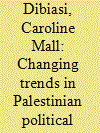

|
|
|
|
|
| Summary/Abstract |
This paper asks where and why Palestinian protests take place and how particular manifestations of territorial dislocation affect the dynamics of Palestinian political activism. Political, social and territorial transformations over the Oslo period had resulted in the fragmentation of Palestinian resistance, a development that had become most evident during the second intifada through the absence of mass-based non-violent protest. Israel’s complex control over Palestinian territory and mobility has been a key factor in driving this fragmentation. In contrast to checkpoints, forbidden roads, and closures, the construction of the Separation Wall had a very different impact, and amid the continuation of a violent and fragmented uprising, it presented a focal point for cohesive organised non-violent local protest. This paper examines to what extent the construction of the Wall has engendered a different type of protest, conception of activism and new forms of cooperation, that break the trend of the second intifada.
|
|
|
|
|
|
|
|
|
|
|
|
|
|
|
|
| 3 |
ID:
116345
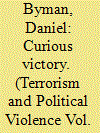

|
|
|
|
|
| Publication |
2012.
|
| Summary/Abstract |
The article examines Israel's successes and failures during the Second Intifada. It argues that Israel's advances came from an effective counterterrorism campaign involving a mix of military operations, defensive measures, and in particular improved intelligence gathering. Domestic resilience also proved strong in the face of a brutal terrorism campaign. Yet long-term victory remains elusive for Israel. Deterrence, always difficult against terrorist groups, is growing harder for Israel. Hamas's control of Gaza, and the mistrust and hatred sown during the Second Intifada, have hindered a political deal between Israel and moderate Palestinians. Much of what went into successful counterterrorism, notably the security barrier and the aggressive campaign of raids and arrests, does not jibe with most visions of what peace would look like and makes a deal harder to achieve. To make a peace deal work, Israeli counterterrorism must change, with measures including relocating parts of the security barrier, bolstering moderate Palestinian politicians, and working with, as opposed to undermining, Palestinian security forces in the West Bank.
|
|
|
|
|
|
|
|
|
|
|
|
|
|
|
|
| 4 |
ID:
191885
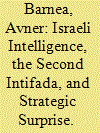

|
|
|
|
|
| Summary/Abstract |
The challenge of this article is on deciding the two-decade-old controversy among Israeli intelligence scholars and practitioners over what caused the outbreak of the Palestinian uprising in October 2000. The question remains: Was it preplanned by the Palestinian Authority or a spontaneous response to the violence that ensued following the visit to the Temple Mount by Israeli opposition leader Sharon, which was seriously escalated by Israel’s excessive military response? Drawing on a theoretical framework of two types of strategic surprises, the article clarifies the controversy and explains the outbreak of what became a long and bloody Israeli–Palestinian confrontation.
|
|
|
|
|
|
|
|
|
|
|
|
|
|
|
|
| 5 |
ID:
090201
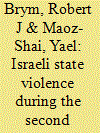

|
|
|
|
|
| Publication |
2009.
|
| Summary/Abstract |
In attempting to explain Israel's retaliatory policies toward Palestinian violence, new institutionalist and rational choice theories vie for dominance. This article argues that both approaches can contribute to understanding the severity of Israel's response if they are viewed as nested explanations appropriate to different threat levels. The article makes its case using data from 74 interviews with senior Israeli counterterrorist experts (2006-07), counts of Israeli and Palestinian fatalities due to state and collective violence (1987-2007), and a database of collective violence events during the Second Intifada (2000-05). Institutional effects are evident at low threat levels, as new institutionalists predict, but these effects are overwhelmed at high threat levels, as rational choice theorists assert.
|
|
|
|
|
|
|
|
|
|
|
|
|
|
|
|
| 6 |
ID:
173845
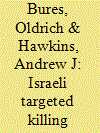

|
|
|
|
|
| Summary/Abstract |
This article offers a contextualized comparison of Israeli targeted killing operations aimed at Palestinian high value targets before and during the Second Intifada. Utilizing four indicators that can be directly attributed to a particular operation (elimination of the intended target, civilian and non-target casualties, directly-linked retaliatory attacks, and adverse political consequences), we analyzed thirty-eight Israeli targeted killing operations to determine whether the policy changes introduced during the Second Intifada (regarding the scale, legal basis, and targeting methods) resulted in increased operational success. Our findings indicate that according to all but the first indicator, Israeli targeted killing operations conducted during the Second Intifada were less successful than those conducted prior to this conflict.
|
|
|
|
|
|
|
|
|
|
|
|
|
|
|
|
|
|
|
|
|